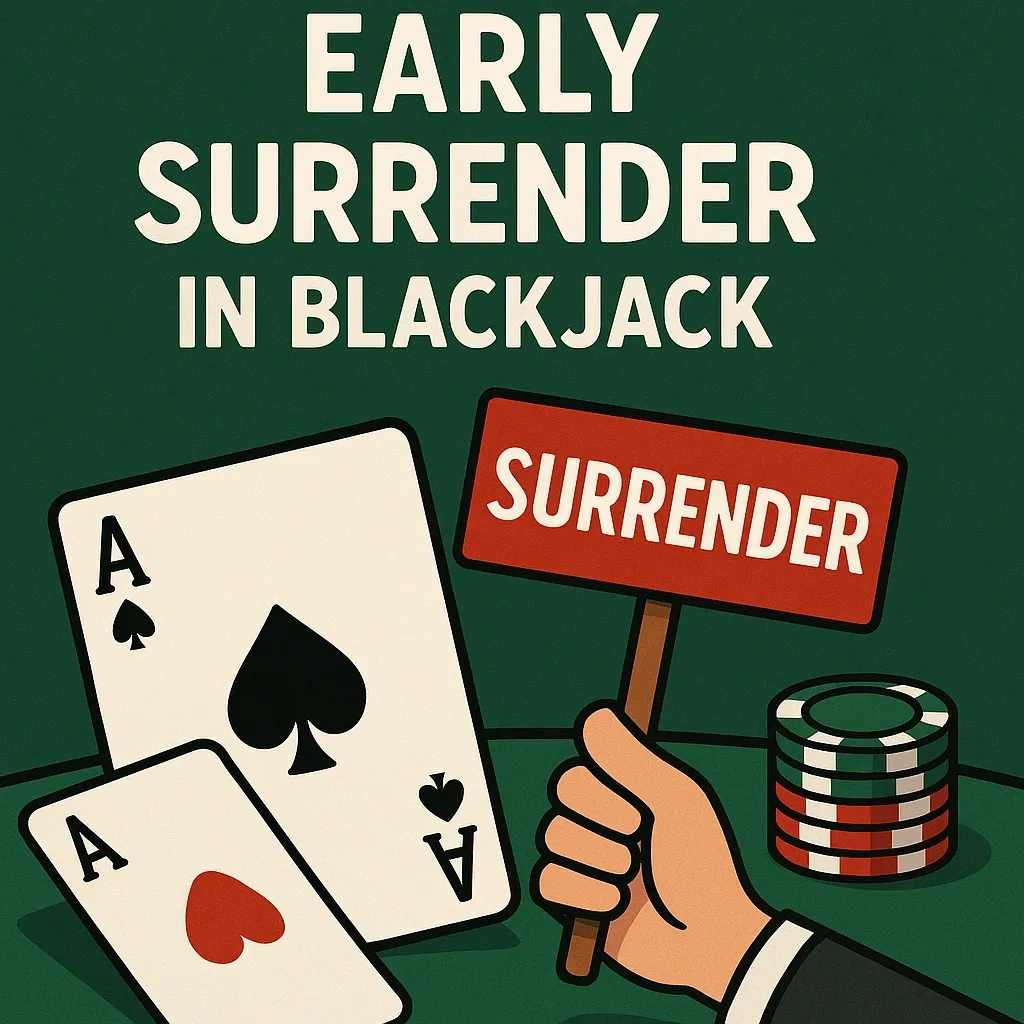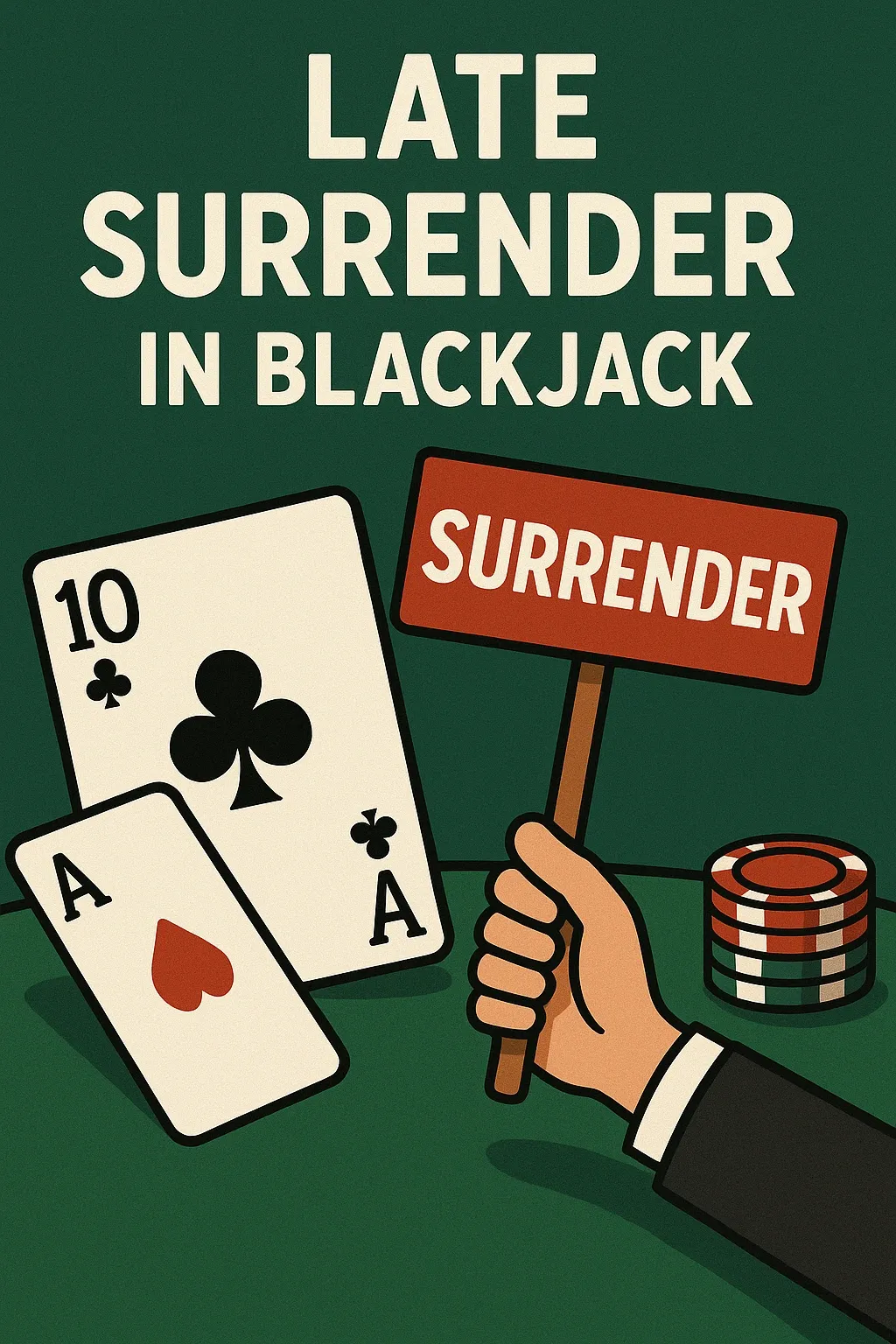Understanding Surrender in Blackjack: A Smart Player's Guide

Surrendering in blackjack isn’t about giving up — it’s a smart way to cut losses when the odds are clearly against you. Knowing when to use it can make a real difference in how long your bankroll lasts. Early and late blackjack surrender both have their place, and using them at the right moment can turn a rough hand into a smaller setback instead of a full loss.
What is surrender in blackjack? This option isn’t on every table, especially in live casinos, but it’s still around. Plenty of online games offer surrender, and once it becomes part of your strategy, it’s easy to spot when it’s worth it. Being able to walk away from a bad hand isn’t weakness — it’s smart play.
What Does Surrender Mean in Blackjack and How Does It Work?
Surrender gives players a way to bow out of a hand before making any other moves. Instead of hitting, standing, or doubling down, you can choose to forfeit the hand and get back half of your original bet. The dealer claims the remaining half, and the round ends right then and there.
This surrender blackjack move works differently from other blackjack options because it happens before you make any playing decisions. You look at your two cards, check the dealer's up card, and decide if the situation looks hopeless enough to cut your losses. Once you surrender, there's no going back - the hand is over.
The Basic Mechanics
What does surrender mean in blackjack? The surrender option is straightforward, though specific steps can differ based on house rules. Most establishments require a specific hand signal or verbal declaration to avoid confusion at the table.
Players typically draw a line behind their bet or say "surrender in blackjack" clearly to the dealer. Online games usually have a surrender button that appears alongside the other playing options. The timing matters because surrender must be the first action taken - you can't hit once and then decide to surrender.
After declaring surrender, the dealer immediately collects half the bet and removes the cards. No further play happens on that hand, and the player moves on to the next round. This quick resolution makes surrender particularly useful when facing obviously bad situations.
Two Types of Surrender Rules
When to surrender in blackjack? There are two main types of surrender, and both have slightly different rules:
- Early Surrender. It gives players the option to quit the hand before the dealer reveals blackjack. It's more favorable, but not often available in most casinos today.
- Late Surrender. Players can use this option once the dealer has verified for a blackjack. If the dealer has a natural, surrender is no longer possible. This version is more common in modern blackjack games, especially online.
The distinction affects strategy significantly because early surrender protects against more dealer hands. What is surrendering in blackjack? Late surrender still helps in plenty of situations, but players need to account for the dealer potentially having blackjack already.
Early Surrender in Blackjack: Rules and Strategies Explained

Early surrender represents the most player-friendly version of this strategic option, though finding it at modern casinos proves increasingly challenging. This rule allows players to forfeit their hand immediately after receiving their initial two cards, even before the dealer peeks for blackjack.
What is a surrender in blackjack? The power of early surrender lies in its timing. Players can escape from terrible situations against any dealer up card, including aces and tens, without worrying about the dealer already having a natural 21.
When to Use Early Surrender
When should you surrender in blackjack? Early surrender creates opportunities that don't exist under standard blackjack rules. The most valuable situations include:
- Hard 16 against any dealer up card. Always surrender these hopeless hands
- Hard 15 against dealer ace or 10. Better to lose half than play out the hand
- Hard 14 against dealer ace. Only in specific multi-deck situations
- Some soft hands against ace. Rare cases where even flexibility doesn't help
These decisions eliminate the guesswork from obviously bad situations and let players focus on hands where skill matters more.
Why Early Surrender Disappeared from Most Blackjack Tables
Early surrender once gave players a solid way to protect their bankroll. By letting them fold their hand before the dealer checked for blackjack, it cut the house edge by around 0.6%. That might seem like a small number, but for casinos, it was too much of a giveaway. Over time, they started removing this rule from regular tables to keep their advantage higher.
What does it mean to surrender in blackjack? Today, early surrender is rarely seen. It may appear during special promotions or in high-stakes areas, where more generous rules are used to bring in serious players. Some online blackjack versions also offer early surrender, but usually only in specific game types.
Players who know about early surrendering in blackjack can spot its value right away. Even though it’s hard to find, understanding how strong it is explains why late surrender still matters. It may not be as generous, but it remains a useful way to limit damage from bad hands.
Late Surrender in Blackjack: When and Why to Use It

Late surrender operates under more restrictive conditions than early surrender, but it still provides valuable opportunities to minimize losses. The dealer must check for blackjack first - if they have a natural 21, surrender becomes impossible and players lose their entire bet.
In blackjack when to surrender depends on many things. Despite these limitations, late surrender remains powerful when used correctly. The key lies in recognizing specific situations where surrendering produces better results than playing the hand.
Late Surrender Strategy Guide
These guidelines help identify the most profitable surrender opportunities under standard multi-deck conditions:
- Facing a 9 from the dealer? Drop your hard 16 — but only if the table runs on four decks or more.
- Dealer showing a 10 or face card? Always surrender hard 16. Hard 15? Fold it only in multi-deck games.
- When the dealer hits on soft 17 with an Ace up, give up hard 16 no matter what. Hard 15 follows the same rule — surrender only in multi-deck setups.
- Dealer standing on soft 17? Surrender that hard 16. As for hard 15, no surrender here — standing is the right call.
Hand composition also matters - a two-card 16 like 10-6 should be surrendered against dealer 10, while a multi-card 16 might warrant hitting.
Common Mistakes to Avoid
Can you surrender in blackjack? Yes! Many players misuse surrender, which costs money over time:
- Surrendering too often. Don't give up on playable hands like 12 against dealer 6
- Never surrendering. Missing clear opportunities like 16 against ace
- Wrong timing. Attempting surrender after hitting or against dealer blackjack
Late surrender reduces the house edge by about 0.08% when used properly, making it a valuable strategic tool worth mastering.
Total-Dependent vs. Composition-Dependent Blackjack Strategies
There are two ways players approach blackjack decisions — by looking at the total of the cards or by looking at how those cards are made. These styles are known as total-dependent and composition-dependent strategies.
The first one, total-dependent, uses just the number value of the player’s hand and the dealer’s card. It doesn’t matter which cards add up to that number — just the total itself. For instance, a hand totaling 16 against a dealer’s 10 is usually played the same way, whether it's made of a 10 and a 6 or an 8 and an 8. This method is straightforward and effective in most cases, forming the basis of many standard strategy charts.
The other type, composition-dependent, pays attention to which cards make up the hand. Not every 16 is treated the same. Two eights can be split, while a 10 and 6 can’t. A soft 18 made from an Ace and 7 might be played differently than one formed another way. Small changes in the hand can lead to better choices when this method is used.
To wrap it up, total-based play is easier to learn, but looking deeper at the hand’s structure gives stronger control. Both styles have value, and smart players know when to apply each one.
FAQ
It’s best to surrender when the dealer has a strong upcard like 9, 10, or Ace, and the player’s hand has low chances of winning, such as 15 or 16.
Late surrender can be found at some Las Vegas casinos, but it’s not common. Early surrender is very rare and mostly unavailable.
Yes, many online blackjack games include a surrender option, especially in European and multi-hand versions. Availability depends on the provider.

Sergey Ilyin
An experienced specialist in the field of betting and gambling. He analyzes market trends, player behavior, and the dynamics of online gaming platform development. An expert in the intricacies of sports betting and knowledgeable about the regulatory framework of the gambling industry.
